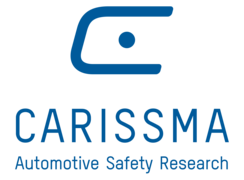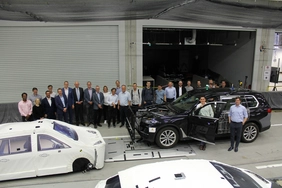The result was a premiere: for the first time, the research team presented a system for the predictive activation of airbags, including a visualization of the entire system chain in real time. A radar-based vehicle detection system utilizing the micro-Doppler effect was used. This enables the prediction of the unavoidability of a collision and the expected severity of an accident based on a worst-case assessment of a vehicle dynamics model.
The research project aimed to develop a comprehensive safety system for highly automated vehicles. To this end, an innovative environment sensor system was developed that can provide precise data about other road users even shortly before a collision and reliably recognize a pre-crash situation, especially in poor light and weather conditions. The stored pre-crash algorithms predict the risk for the occupants and decide on the use of safety measures to prevent accidents and minimize their consequences. The possibilities of active steering and braking interventions with control up to the physical limits were investigated, as well as innovative, intelligent airbag systems that can be deployed a few moments before the collision and controlled during the collision to optimize the restraining effect. To make the systems robust for use on public roads, they were secured and tested in advance in C-ISAFE's indoor rain and fog facility.
With the test vehicles from VorSAFe-Plus, THI expanded the existing test facilities of CARISSMA, the research and test centre for vehicle safety. The test vehicles formed the technical basis for a mobile innovation laboratory for automated driving.
In addition to C-ISAFE, the project partners included the global players in the Bavarian automotive industry BMW, Continental Automotive Technologies (Regensburg), Continental Automotive Distance Control Systems (Lindau) and AKKODIS. The consortium was complemented by ANavS GmbH, a Munich-based start-up company specialising in high-precision positioning and environmental detection. Other associated partners beyond the borders of Bavaria were the Alliance Centre for Technology (AZT) and the Lower Saxony Research Centre (NFF). Professor Christian Birkner, an expert in vehicle systems and their control, led the project together with Professor Thomas Brandmeier, Head of C-ISAFE, and Professor Lothar Wech.


![[Translate to English:] Logo Akkreditierungsrat: Systemakkreditiert](/fileadmin/_processed_/2/8/csm_AR-Siegel_Systemakkreditierung_bc4ea3377d.webp)








![[Translate to English:] Logo IHK Ausbildungsbetrieb 2023](/fileadmin/_processed_/6/0/csm_IHK_Ausbildungsbetrieb_digital_2023_6850f47537.webp)


